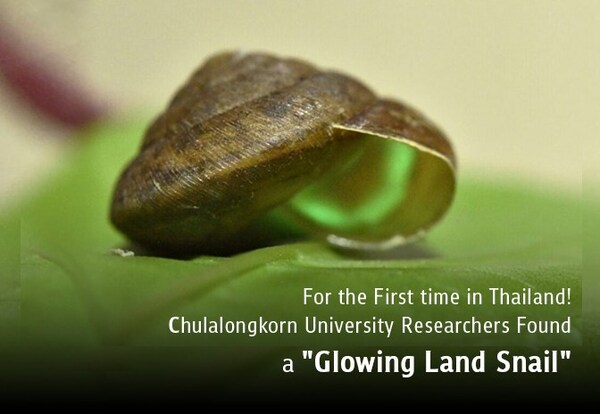BANGKOK, July 24, 2024 /PRNewswire/ — Chulalongkorn University researchers have discovered Thailand’s first glowing land snail and the first one in the world in the last 80 years. Preparations are underway to decode its genetics paving the way to expand medical research and scientific knowledge.
The world’s first glowing land snail (Quantula striata) was found in 1942 in Singapore by Dr. Yata Haneda, a Japanese researcher, and it was then the only glowing snail species in the world.
Almost 80 years later, a glowing land snail was discovered once again in Thailand by a team of researchers led by Dr. Arthit Pholyotha, Department of Biology, Faculty of Science, Chulalongkorn University who discovered Phuphania glowing land snail living in limestone areas, Kaeng Khoi District, Saraburi Province.
The research team submitted the information concerning this discovery to the “International Mollusc of the Year 2024” competition and were voted first place in the competition that attracted scientists from around the world.
The top three shellfish and squid voted on the https://moty2024.senckenberg.science/en/ website are: Thailand’s glowing land snails (first place), Wavy Sea Butterfly (second place), and Coosa Fiveridge — the oldest living mollusc at 79 years (third place).
What is special about the Thai glowing land snail?
The Quantula land snail discovered by Japanese researchers cannot emit green light continuously but it emits green light as a small spot under the mouth flashing rhythmically which can only be seen when it is moving. On the other hand, the Thai Phuphania snail is special in that it can emit green light continuously.
Future research on land snail
Assistant Professor Dr. Piyoros Thongkerd a member of the research team said that in addition to studying land snail, a research team from the Faculty of Science at Chulalongkorn University is studying “Snail mucus” for medical benefits, especially in the production of gauze bandages.
Currently, the research team has collaborated with the Faculty of Medicine, Chulalongkorn University, to study the genomes of land snail to find proteins involved in the production of sticky mucus. The discovery of these proteins will shed light on the biological processes that allow snail to produce their unique mucus properties and may lead to the development of highly effective medical products in the future.
Read the full article at https://www.chula.ac.th/en/highlight/174216/
Media Contact:
Chula Communication Center
Email: Pataraporn.r@chula.ac.th
View original content to download multimedia: Read More


